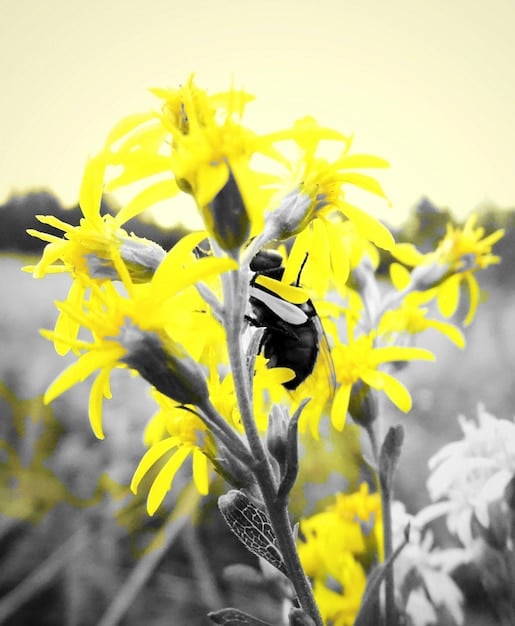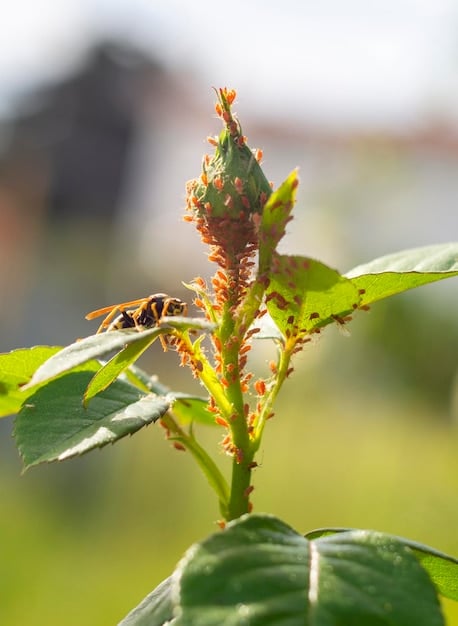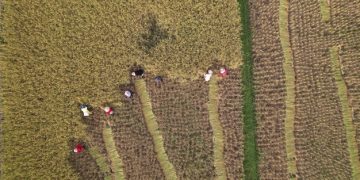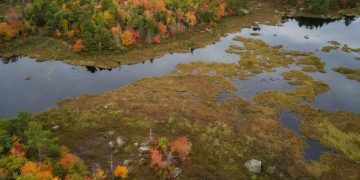New US Regulations Protect Pollinators from Pesticide Use

Recent updates to US regulations on pesticide use aim to protect pollinator populations by restricting certain harmful pesticides and promoting integrated pest management strategies.
The United States has implemented recent updates: new regulations on pesticide use aim to protect pollinator populations in the US, marking a significant step towards safeguarding these vital creatures and their essential role in our ecosystems and food supply.
Understanding the Importance of Pollinators
Pollinators, including bees, butterflies, and other insects, are critical for the reproduction of many plants. These creatures play a vital role in agriculture and maintaining biodiversity, making their health crucial for both ecological and economic stability.
The declining populations of pollinators have raised alarms, prompting action from various governmental and environmental organizations. Pesticides, particularly neonicotinoids, have been identified as a major threat to these delicate ecosystems.

The Role of Pollinators in Ecosystems
Pollinators enable the reproduction of approximately 75% of the world’s flowering plants and 35% of global food crops.
- They support the production of fruits, vegetables, and nuts.
- They maintain the genetic diversity within plant species.
- They underpin the health and stability of natural ecosystems.
Threats to Pollinator Populations
Several factors contribute to the decline of pollinator populations. The most significant are habitat loss, climate change, diseases, and pesticide use.
- Habitat loss reduces the availability of food and nesting sites for pollinators.
- Climate change alters flowering patterns and disrupts the synchrony between pollinators and plants.
- Pesticides directly poison pollinators and disrupt their nervous systems.
Protecting these essential species requires a multi-faceted approach, focusing on habitat restoration, responsible pesticide use, and education.
In summary, pollinators are indispensable for both natural ecosystems and agriculture. Recognizing the threats they face and implementing effective conservation measures are paramount for their survival and the services they provide.
Overview of the New Pesticide Regulations
The new regulations aim to mitigate the negative impact of pesticides on pollinators. They include restrictions on the use of specific pesticides and promotion of integrated pest management (IPM) practices.
These measures represent a proactive approach to addressing pollinator decline and ensuring the sustainability of agricultural practices.
Key Components of the Regulations
The recent regulations focus on limiting the use of pesticides known to be harmful to pollinators.
- Restrictions on neonicotinoids, which have been shown to impair the navigation and foraging abilities of bees.
- Mandatory labeling requirements to inform consumers about the potential risks of pesticides.
- Increased funding for research into alternative pest control methods.
Integrated Pest Management (IPM)
IPM involves using a variety of methods to control pests while minimizing harm to non-target species.
- Crop rotation and diversification to disrupt pest cycles.
- Biological control agents, such as beneficial insects and microorganisms.
- Careful monitoring of pest populations to avoid unnecessary pesticide applications.
The implementation of these regulations necessitates collaboration between farmers, researchers, and policymakers to ensure effective protection for pollinators.
The new pesticide regulations mark a pivotal step in safeguarding pollinator populations and promoting environmentally sound agricultural practices. They underscore the urgency of protecting these vital species and fostering sustainable ecosystems.
Impact on Agricultural Practices
These regulations will inevitably influence the methods and strategies employed by farmers across the United States. The changes encourage the adoption of integrated pest management techniques.
While these changes may initially require some adjustments, they are ultimately designed to ensure long-term sustainability and productivity in agriculture.

Changes in Pesticide Use
Farmers may need to reduce or eliminate the use of certain pesticides, particularly neonicotinoids, which are known to be harmful to pollinators.
- This change necessitates implementing alternative pest control methods.
- Farmers must adopt more targeted and efficient pesticide applications.
- Regular monitoring of pest populations is essential to reducing pesticide use.
Adoption of IPM Strategies
Integrated Pest Management (IPM) offers a sustainable approach to pest control that minimizes harm to beneficial insects and the environment.
- IPM practices enhance biodiversity and ecosystem resilience.
- IPM reduces the risk of pesticide resistance in pest populations.
- IPM promotes sustainable and long-term crop productivity.
The shift towards IPM also has economic implications, potentially reducing costs associated with pesticide applications while enhancing crop yields and quality.
Ultimately, the impact on agricultural practices signifies a positive shift towards sustainable and environmentally conscious farming. The regulations promote a more balanced and resilient approach to pest management.
Benefits for Pollinator Populations
The primary objective of these new regulations is to provide significant benefits for pollinator populations. By reducing their exposure to harmful chemicals, the regulations aim to support their health and survival.
These benefits extend beyond the pollinators themselves, contributing to the overall health and resilience of ecosystems.
Improved Health and Survival Rates
Reducing pesticide exposure enhances the health and longevity of pollinators.
- Reduces the risk of direct poisoning and sublethal effects.
- Supports the ability of pollinators to forage and navigate effectively.
- Contributes to stable and growing pollinator populations.
Enhanced Ecosystem Biodiversity
Healthy pollinator populations contribute to the overall biodiversity and resilience of ecosystems.
- Promotes the reproduction of a wider range of plant species.
- Supports the food web and interactions between species.
- Contributes to the stability and functioning of natural habitats.
The improvements in pollinator health and biodiversity are essential for long-term ecological stability and sustainability. These benefits extend to agriculture by supporting the production of diverse and healthy crops.
The benefits for pollinator populations underscore the importance of responsible pesticide management. These regulations play a vital role in ensuring the long-term health and resilience of pollinators and the ecosystems they support.
Challenges and Implementation
Effectively implementing these new regulations presents several challenges. Stakeholders need to address these challenges collaboratively to ensure the successful protection of pollinator populations.
These challenges include economic constraints, technical limitations, and the need for ongoing education and communication.
Economic Constraints
Adopting IPM practices or alternative pest control methods may incur additional costs for farmers, particularly in the short term.
- Some farmers may lack the resources to invest in new equipment or training.
- The financial burden could affect the competitiveness of smaller farming operations.
- Governmental support and incentives may be needed to offset these costs.
Technical Limitations
Some alternative pest control methods may not be as effective or convenient as traditional pesticides, leading to concerns about crop yield and quality.
- Finding suitable biological control agents or IPM strategies for all crops may require further research.
- Monitoring pest populations and applying targeted interventions requires specialized expertise.
- The uncertainty about the effectiveness of alternative methods may deter some farmers from adopting them.
Overcoming these challenges necessitates a collaborative approach, involving financial support, technical assistance, and educational initiatives. Successful implementation will ensure the regulations achieve their intended goals and result in sustainable outcomes for pollinators, agriculture, and the environment.
The challenges in implementing these new regulations should not overshadow the commitment to protecting pollinator populations. Addressing these challenges calls for cooperation, innovation, and sustained efforts from all stakeholders to realize the long-term benefits.
Future Directions and Research
Continued research and innovation are essential for improving pesticide management and enhancing the conservation of pollinator populations. The ongoing pursuit of knowledge is crucial for refining practices and policies.
Future research should focus on developing more effective and safer pest control methods, as well as gaining a deeper understanding of pollinator biology and behavior.
Developing Safer Pesticides
Research efforts should prioritize the development of pesticides that are less toxic to pollinators and other beneficial insects.
- Investigating new compounds with targeted effects on specific pests.
- Developing formulations that reduce drift and exposure to non-target organisms.
- Testing and refining pesticide application methods to minimize environmental impacts.
Understanding Pollinator Biology
Gaining a deeper understanding of how pollinators respond to environmental stressors is crucial for implementing targeted conservation strategies.
- Studying the effects of pesticides on pollinator development and behavior.
- Identifying the factors that contribute to pollinator habitat selection and foraging success.
- Investigating the impacts of climate change and habitat fragmentation on pollinator populations
Continued funding for research and innovation is essential for safeguarding these vital species and ensuring the long-term sustainability of ecosystems. Continued monitoring and evaluation of these regulations should also inform ongoing policy development.
The future direction of pesticide management and pollinator conservation lies in continuous innovation and learning. This ongoing effort will support a balance between agricultural practices and the preservation of our planet’s biodiversity.
| Key Point | Brief Description |
|---|---|
| 🌱 Regulation Overview | New pesticide regulations aim to protect pollinators by restricting harmful chemicals. |
| 🐝 Impact on Agriculture | Farmers may reduce pesticide use & adopt Integrated Pest Management (IPM) |
| 🌎 Benefits for Ecosystems | Improved pollinator health & enhanced biodiversity |
| 🔬 Future Research | Developing safer pest control and understanding pollinator biology are crucial |
Frequently Asked Questions
▼
The regulations primarily aim to reduce the harm to pollinator populations from pesticide exposure, protecting them from chemicals that negatively impact their survival and reproduction.
▼
Neonicotinoids are the most affected group of pesticides, given their known negative effects on pollinator’s nervous systems and their capacity to disrupt the foraging and navigational abilities.
▼
Farmers will likely need to adopt integrated pest management (IPM) strategies, promoting biological control, crop rotation, and reduced reliance on harmful chemical inputs.
▼
Reduced chemical exposure will overall improve pollinator health, enhance ecosystem biodiversity and support the propagation of a wide range of flowering plants and food crop species.
▼
Implementation may encounter challenges that include economic strains on the farming community, lack of resources to adopt alternative pest control, technical constraints and finding equally effective eco-friendly methods.
Conclusion
The recent updates to US regulations on pesticide use signify a crucial step in protecting pollinator populations. By addressing the risks posed by harmful chemicals and promoting integrated pest management, these regulations contribute to the health and resilience of both ecosystems and agricultural practices.





